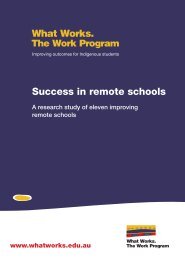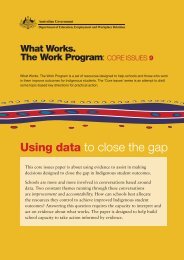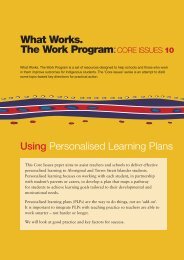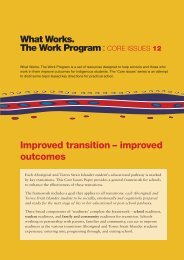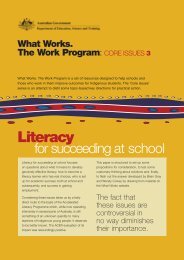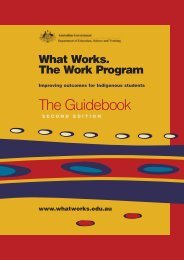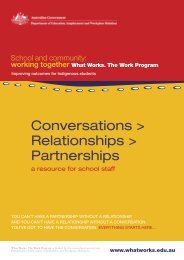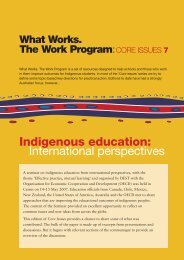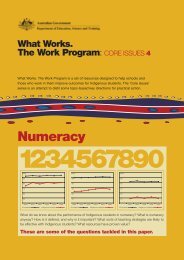HEALTH AND PHYSICAL EDUCATIONMovement SkillsIn Year 1the student:In Year 2the student:In Year 3the student:In Year 4the student:In Year 5the student:In Year 6the student:In Year 7the student:In Year 8the student:In Year 9the student:In Year 10the student:• Moves freely in a space -hop, skip, gallop, run, roll<strong>and</strong> combinations of these− both spontaneously <strong>and</strong>when prompted by voice,music or signal (e.g.whistle).• Explores differentmovements withdifferent body parts (e.g.pull, push, swing, twist,sway, bend <strong>and</strong> crawl).• Transitions from onesurface or position toanother (e.g. jump, step,swing, roll).• Manipulates equipment(e.g. hoop, ball, rope, stickor floatation aid) usingtechniques such as grip,twist, swing, throw <strong>and</strong>hit.• Creates simplemovement sequences -(e.g. imitating familiaranimals like kangaroo <strong>and</strong>snake) − while stationary<strong>and</strong> while moving freely<strong>and</strong> safely aroundequipment <strong>and</strong> people.• Describes cause <strong>and</strong>effect in relation tobalance, swing, l<strong>and</strong>ing<strong>and</strong> the manipulation ofequipment (e.g. I balanceeasier when I spread myfeet a little wider).• Describes indicators thatreflect physicalcondition including hot,cold, sweaty, puffed <strong>and</strong>thirsty.• Participates in simpleteacher-led games suchas ‘Simon Says’.• Demonstrates increasingconfidence <strong>and</strong>familiarity with basiclocomotor skillsincluding hop, skip <strong>and</strong>run.• Moves in response todifferent comm<strong>and</strong>sincluding stop, start <strong>and</strong>change direction; take off<strong>and</strong> l<strong>and</strong> – one foot <strong>and</strong>both feet – changedirection to avoidobstacles, <strong>and</strong> changespeed.• Pushes off from shallowwater, swim 10 meters indeep water <strong>and</strong> treadwater confidently.• Develops a range ofobject control skillsusing h<strong>and</strong>s, feet <strong>and</strong>equipment (e.g. bean bag,small bat <strong>and</strong> soft ball).Control skills include:roll, throw, catch, trap,strike <strong>and</strong> dribble – whilestationary <strong>and</strong> moving ona range of surfaces.• Experiments with simplemovement principlessuch as: weight transfer;follow through; <strong>and</strong> keepa low base of support <strong>for</strong>best balance.• Demonstrates how thebody adjusts to differentdem<strong>and</strong>s (e.g. breathingmore heavily during <strong>and</strong>after a run).• Describes the benefits ofphysical activityincluding: having fun <strong>and</strong>being with friends.• Applies the rules ofplayground games (e.g.games of chase) – <strong>and</strong> hasthe confidence to join in.• Demonstrates the fullrange of fundamentalmovement skills <strong>and</strong>body management skillsincluding:− rhythmic actions withh<strong>and</strong>s <strong>and</strong> feet as indance,− moving confidentlythrough, over <strong>and</strong>around equipment,other participants, atdifferent levels <strong>and</strong> ondifferent surfaces,− stop, start <strong>and</strong> changedirection safely <strong>and</strong>efficiently.• Swims confidently over20 meters usingbreaststroke, crawl(freestyle) or sidestroke.• Demonstrates a range ofways to use body position,balance, acceleration <strong>and</strong>other movement conceptsto participate effectivelyin play <strong>and</strong> simplegames.• Applies basic movementprinciples to create thedesired per<strong>for</strong>mance (e.g.st<strong>and</strong> side-on <strong>and</strong> followthrough to throw <strong>for</strong>distance <strong>and</strong> accuracy).• Demonstrates competentobject control skills suchas:− roll a hoop, ball orother equipment,− throw <strong>and</strong> catch a beanbag or soft ball,− strike <strong>and</strong> dribble a ballwith foot, h<strong>and</strong> or shorth<strong>and</strong>led bat,− skip a rope turned byself or others,− run with a ball,− use a kickboard or otherflotation aid.• Describes the intensity ofphysical activity – low,medium, high – from thebody’s reaction (e.g.warm <strong>and</strong> com<strong>for</strong>table vsvery hot, sweaty <strong>and</strong>tired).• Demonstrates ways tomanage the risk involvedwith physical activities(e.g. falls <strong>and</strong> feelingtired).• Demonstrates cooperativeteam-work, use of space<strong>and</strong> personal skills toparticipate in minor games(e.g. tag <strong>and</strong> dodge).• Demonstrates proficiencyin fundamentalmovement skillsincluding static balance,sprint run, vertical jump,catch, hop, side gallop,skip <strong>and</strong> over-arm throwthrough practice <strong>and</strong>application in differentgames <strong>and</strong> sports.• Describes <strong>and</strong> appliesbasic movementprinciples to improvetechnique (e.g. usepreparatory steps to buildmomentum, bend knees toreduce impact on l<strong>and</strong>ing,alter the angle of ballrelease to maximisedistance, <strong>and</strong> change bodystance to maximisestability <strong>and</strong> balance).• Describes the physical,social <strong>and</strong> emotionalbenefits of physicalactivity includingbuilding strength <strong>and</strong>speed, <strong>and</strong> feeling goodabout oneself.• Compares the effects onthe body of participationin physical activities ofdifferent types <strong>and</strong>intensities including: thedifference in heart ratewhen at rest, walking <strong>and</strong>jogging. Explains whythese changes occur.• Applies movement skillswith consistency <strong>and</strong>control <strong>and</strong> practicesmanipulative skills usingequipment in a range ofminor games that requireteamwork, ef<strong>for</strong>t <strong>and</strong>rules.• Describes how everydayactivities <strong>and</strong> physicalpursuits contribute togeneral fitness <strong>and</strong>wellbeing.• Explains how variousfactors, such as availablefacilities, disability <strong>and</strong>preference may influencechoices <strong>and</strong>participation in physicalactivity.• Per<strong>for</strong>ms coordinatedactions, object-controlskills <strong>and</strong> sequences (e.g.a pass in football <strong>and</strong> adribble in basketball).Demonstrates these skillsto a level where they canper<strong>for</strong>m through <strong>and</strong>around obstacles <strong>and</strong> inmodified games of (e.g.soccer, basketball <strong>and</strong>football).• Recognises, describes <strong>and</strong>applies movementprinciples such asdynamic balance <strong>and</strong>stability (e.g. inthrowing), adjusting thebody to preventoverbalance (e.g. inkicking), lowering bodyposition when turning <strong>and</strong>pushing off with theopposite foot (e.g. inbasketball).• Describes differentaspects of physicalactivity (e.g. type,frequency, intensity <strong>and</strong>duration) <strong>and</strong> be.g.ins toreflect on how theseimpact on per<strong>for</strong>mance<strong>and</strong> health.• Demonstrates simpletactics <strong>and</strong> strategies,such as creating <strong>and</strong>defending space, toenhance individual <strong>and</strong>team per<strong>for</strong>mance in avariety of physicalactivities.• Participates in <strong>and</strong>describes how physicalactivity contributes to abalanced, healthy <strong>and</strong>active lifestyle <strong>and</strong>identifies the differentcomponents of healthrelatedfitness.• Participates confidently<strong>and</strong> skilfully in games<strong>and</strong> modified sportsdemonstrating a comm<strong>and</strong>of the rules.• Describes barriers tore.g.ular participation inphysical activity <strong>and</strong>suggests some ways toenhance participation byall people.• Participates in a range ofmoderate to vigorousphysical activities <strong>and</strong>applies movement skillsincluding the leap, kick,two-h<strong>and</strong>ed pass <strong>and</strong>dodge − with increasedconfidence, coordination<strong>and</strong> precision.• Monitors <strong>and</strong> adjustsown per<strong>for</strong>mance byconsidering circumstances<strong>and</strong> applying knowledgeof basic movementprinciples (e.g. limit longpasses in windyconditions, expect slowerball speed on a wetsurface).• Takes <strong>and</strong> records simplemeasures (e.g. heart rate)to track the body’sresponse to physicalactivity.• Applies the relationshipsbetween principles ofmovement <strong>and</strong>per<strong>for</strong>mance in sport(e.g. steady the bodybe<strong>for</strong>e releasing abasketball shot, keep lowto block or to tackle anon-coming player).• Demonstrates teamwork<strong>and</strong> tactics such asmoving to a space toreceive a moving ball, orworking with a team-mateto outmanoeuvre anopponent.• Applies basic offensive<strong>and</strong> defensive strategiesin games (e.g. using thebody to protect the ballwhile it is in mypossession).• Devises <strong>and</strong> implements abasic game plan.• Devises a personal planto ensure a healthy levelof physical activity, athome <strong>and</strong> at school,illustrating underst<strong>and</strong>ingof the importance ofphysical activity <strong>for</strong>health, <strong>and</strong> a balancebetween active <strong>and</strong>passive pursuits.• Demonstrates increasingcompetence in variousgames through mastery ofskills <strong>and</strong> tactics,awareness of personal <strong>and</strong>opposition strengths, <strong>and</strong>appreciation of the rules<strong>and</strong> strategies of the game.This includes learning <strong>and</strong>practising:− specialised roles <strong>and</strong>different positions in ateam (e.g. offence,defence, sweeper),− strategies <strong>for</strong>monitoring opponents− techniques <strong>for</strong>creating, using <strong>and</strong>defending space.• Identifies <strong>and</strong> participatesin physical activities thatdevelop particularcomponents of healthrelatedfitness including:strength, speed,endurance. Explains howgeneral fitness is animportant aspect ofphysical per<strong>for</strong>mance <strong>and</strong>an essential component ofoptimum health <strong>and</strong>wellbeing.• Investigates the healthrisks associated with asedentary lifestyle.Monitors <strong>and</strong> sets goals<strong>for</strong> adjusting daily <strong>and</strong>weekly physical activitylevels to eliminate orreduce the risk.• Investigates the factorsthat influenceparticipation in physicalactivity. Identifiesactivities that have thepotential to meet theirpresent <strong>and</strong> future needs,taking into considerationthe changes that may takeplace when moving tohigh school. Choosesactive pursuits that suitpersonal interests <strong>and</strong>body characteristics.Justifies activity choicesin terms of interests,abilities <strong>and</strong> healthbenefits.• Executes specialised<strong>for</strong>ms of passing,shooting, tagging,tackling, blocking <strong>and</strong>stopping to suit differentcircumstances (e.g. chest,shoulder, overhead <strong>and</strong>bounce pass; drawing aplayer <strong>and</strong> h<strong>and</strong>passing tothe space in front of ateam mate).• Participates in a rangeof physical activities inincreasingly complexenvironments, (e.g.competitive, noncompetitive,individual,group, fitness initiatives)to maximise participation<strong>and</strong> enjoyment, <strong>and</strong>further enhance skills <strong>and</strong>strategies.• Plans <strong>and</strong> per<strong>for</strong>msmovement sequencesusing the elements ofcomposition (e.g. puttingtogether a sequence ofsteps in an aerobics/danceroutine, or designing <strong>and</strong>implementing a set play inbasketball).• Demonstrates appropriatesports conventions (e.g.sportsmanship) <strong>and</strong> safetyprinciples.• Plans <strong>and</strong> implementsways of improvingphysical per<strong>for</strong>mance byestablishing goals, thenusing feedback fromcoach, fellow player <strong>and</strong>other sources to buildskills <strong>and</strong> strategies.• Participates confidently<strong>and</strong> regularly, preferablydaily, in sport orrecreational activities ofsufficient intensity to havea health benefit.• Makes decisions aboutchanges in technique orstrategy based on a soundunderst<strong>and</strong>ing ofmovement principles <strong>and</strong>a capacity to ‘read theplay’.• Moves efficiently <strong>and</strong>effectively to achieveobjectives such ascreating space, protectingthe ball, <strong>for</strong>cing anopponent off-side (or outof position), <strong>and</strong> adaptingto changed conditions.• Devises, implements <strong>and</strong>evaluates individualoffensive <strong>and</strong> defensiveskills in a team strategy(e.g. double teaming anopponent, using a series ofpasses to outmanoeuvreopponents).• Demonstrates enhancedcompetence in games by:− using feedback fromcoach to adjusttechnique,− applying knowledge of<strong>for</strong>ce <strong>and</strong> motion toadjust technique <strong>for</strong>changed circumstancessuch as slipperysurface,− choosing strategiesfrom a repertoire ofpossibilities, toaccommodate changedcircumstances such as anew opponent or newgame plan,− interpreting umpiringdecisions <strong>and</strong> applyingrules to own advantage(e.g. drawing a foul inbasketball),− implementing preplannedstrategies tore.g.ain the ascendancyin a game (e.g. switchto zone defence inbasketball).• Officiates (umpire, score)or coach a familiar gamewith support (e.g. help outat a modified games day<strong>for</strong> junior participants).• Participates with successin a range of physicalactivities adapting <strong>and</strong>transferring skills,strategies <strong>and</strong>techniques to suitdifferent circumstances(e.g.:− use skills <strong>and</strong>knowledge gained fromlessons <strong>and</strong> experiencein tennis to participatesuccessfully in a relatedgame such as squash orbadminton,− adapt skills <strong>and</strong>strategies from thecompetitive sportsarena to buildcompetence <strong>and</strong> gainenjoyment from activerecreational activitiessuch as bushwalking).• Appraises <strong>and</strong> evaluatesskills, tactics <strong>and</strong> teamworkin a variety ofgames, dance <strong>and</strong>recreation activities.Demonstrates <strong>and</strong>discusses how thein<strong>for</strong>mation gained can beused to further enhanceper<strong>for</strong>mance <strong>and</strong>enjoyment.• Promotes <strong>and</strong> models anactive lifestyle throughinvolvement in roles suchas player, team leader,coach, administrator,advocate, official orpromoter. (School use ofthe Sport Education modelis one way to providethese opportunities <strong>for</strong>students in a supportiveenvironment).<strong>Bound</strong> <strong>for</strong> <strong>Success</strong> <strong>Scope</strong> <strong>and</strong> <strong>Sequence</strong> <strong>Statements</strong> V2 Page 21 Working Document Semester One 2007
HEALTH AND PHYSICAL EDUCATIONPersonal DevelopmentIn Year 1the student:In Year 2the student:In Year 3the student:In Year 4the student:In Year 5the student:In Year 6the student:In Year 7the student:In Year 8the student:In Year 9the student:In Year 10the student:• Describes emotionsincluding happy, excited,shy <strong>and</strong> frightened.• Discusses the importanceof managing emotions –that it’s OK to feel angry<strong>and</strong> tell someone but it’snot OK to react violentlyin anger. Plans <strong>for</strong> <strong>and</strong>applies alternativereactions to challengingsituations (e.g. take threedeep breaths be<strong>for</strong>e retryinga difficult task).• Identifies characteristicsthat make individualsdifferent from others <strong>and</strong>there<strong>for</strong>e ‘special’.• Demonstratescooperation in smallgroups in work <strong>and</strong> playincluding: taking turns,sharing equipment,communicatingeffectively, makingfriends.• Discusses changes thatare being experiencedincluding: growing taller,learning to read, makingnew friends, losing babyteeth.• Applies appropriateconventions, includingmanners <strong>and</strong> schoolprocedures, when relatingto teacher/s, other students<strong>and</strong> visitors.• Explores ‘self’ in thecontext of family,friendship group <strong>and</strong>school. Identifies personalqualities, interests,learning styles <strong>and</strong> othercharacteristics.• Role plays assertive voice<strong>and</strong> posture − brave talk(e.g. when a friend wantsto break a school rule orwhen reporting anincident, or advocating <strong>for</strong>a friend).• Identifies body cues –such as ‘butterflies’ – thatsignal changes in personalfeelings. Manages theseemotions in challengingsituations (e.g. speaking infront of the whole class<strong>and</strong> attempting a newskill).• Demonstrates ways toencourage <strong>and</strong> supportothers including listeningattentively to news,spending time playingwith friends, <strong>and</strong> invitingothers to join in a game.• Demonstrates skills <strong>for</strong>cooperation, safety <strong>and</strong>independence withequipment, <strong>and</strong>demonstrates acceptanceof situations where thereare winners <strong>and</strong> losers.• Describes personal needs<strong>and</strong> interests <strong>and</strong> howthey have changed frominfancy to the presenttime.• Explains qualities <strong>and</strong>characteristics that aresimilar to <strong>and</strong> differentfrom other people <strong>and</strong>how this contributes to asense of self. Describescharacteristics <strong>and</strong>qualities that make allpeople unique such as eyecolour, generosity,friendliness.• Labels a ‘high five’diagram − on each fingerof a h<strong>and</strong> nameappropriate friends <strong>and</strong>family to seek help fromwhen feeling lonely,unsafe or simply wantingcompany.• Discusses how roles <strong>and</strong>responsibilities changeas we grow older <strong>and</strong> thatmales <strong>and</strong> females mayhave different needs <strong>and</strong>interests.• Discusses physicaldifferences betweenmales <strong>and</strong> femalesincluding body shape <strong>and</strong>different sex organs.Discusses how a variationin growth rates amongpeers is normal.• Justifies actions infamiliar situations <strong>and</strong>differentiates between ‘Ihave to’ <strong>and</strong> ‘I want to’.Identifies what actions areof personal importance(e.g. says “ I like to paint<strong>and</strong> I like outdoorgames”).• Discusses how positiverelationships enhancefeelings <strong>for</strong> all who areinvolved in therelationship.Demonstrates cooperativeskills (e.g. I involve othersby pausing or altering anactivity <strong>and</strong> inviting themto join in).• Demonstrates personalresponsibility inclassroom <strong>and</strong> otheractivities (e.g. taking onspecific roles <strong>and</strong>following through oncommitments).• Switches between codesof behaviour to suitcircumstances, such assports field to classroom,home to school.• Explains how differentways of describing <strong>and</strong>relating to other peopleinfluences the way peoplevalue <strong>and</strong> treatthemselves <strong>and</strong> others.• Identifies the physicalchanges that occur aspeople age such as gettingtaller, stronger <strong>and</strong>knowing more, <strong>and</strong> howthese changes can beeffected by good health(e.g. a balanced diet <strong>and</strong>active lifestyle enhancesenergy, helps preventillness <strong>and</strong> contributes to aheightened sense ofwellbeing).• Explores <strong>and</strong> recognisesfeelings associated withbody changes duringgrowth.• Manages emotions usinga variety of strategies suchas counting to ten,prioritising tasks, takingpreventive action, selftalk,early recognition,changing things that canbe changed throughplanning <strong>and</strong> practice.• Devises <strong>and</strong> role playsstrategies to solveproblems <strong>and</strong> manageconflict while recognising<strong>and</strong> accepting differences<strong>and</strong> the rights, values <strong>and</strong>feelings of others.• Demonstrates actions,behaviours <strong>and</strong> attitudesthat support positiverelationships withdifferent groups of people,including people fromother cultures (e.g. how tobe.g.in conversation witha new student, ways toinclude others in socialactivities, learning aboutthe beliefs <strong>and</strong> traditionsof other cultural groups).• Describes a wider rangeof feelings <strong>and</strong> emotionsassociated with change<strong>and</strong> describes how peoplemanage them. Explainshow emotions can bere.g.ulated by managingcircumstances <strong>and</strong>deepening selfunderst<strong>and</strong>ing.Uses richervocabulary (synonyms) todescribe emotions (e.g.amused, delighted,thrilled or overjoyedinstead of happy).• Role plays ways tomanage being left out,ignored, put down, notselected, teased or losingincluding what to do, howto manage emotions, <strong>and</strong>where to get help.• Explores different roles<strong>and</strong> responsibilities inrelationships <strong>and</strong> takeson various roles withingroup activities with afocus on communicationskills <strong>and</strong> positive ways todeal with conflict.• Demonstrates assertiveverbal <strong>and</strong> non-verbalcommunication withfriends <strong>and</strong> family (e.g.explaining views about asensitive issue).• Describes the changesthat occur duringpuberty <strong>and</strong> how the rateof change varies amongindividuals.• Demonstrates ways toshow care <strong>and</strong> respectincluding assisting othersto communicate, offering<strong>and</strong> accepting help, <strong>and</strong>asking permission.• Role plays ways to join anew group <strong>and</strong> initiate<strong>and</strong> maintainconversation.• Actively contributes togroup cohesion <strong>and</strong>effectiveness by offeringopinions, listeningattentively, seekingclarification, acceptingresponsibility, followinginstructions.• Describes the physical,social <strong>and</strong> emotionalfactors that influencepersonal identity, <strong>and</strong>how one’s sense ofidentity may changeduring puberty.• Discusses how pubertalchanges may affectrelationships <strong>and</strong> selfesteem.• Demonstrates moreadvanced skills <strong>for</strong>establishing <strong>and</strong>maintaining positive <strong>and</strong>caring relationshipsincluding: empathy <strong>and</strong>respect in relationships,expressing feelings <strong>and</strong>points of viewappropriately, negotiating,effective communication,<strong>and</strong> practising assertivebehaviours. Demonstrateshow to deal with positive<strong>and</strong> negative commentsfrom peers.• Manages conflict throughstrategies <strong>and</strong> attributesincluding: re-evaluatingpersonal position, selfmonitoringvoice tone <strong>and</strong>volume, separating theperson from the issue,offering suggestions,accepting the umpire’sdecision, negotiating ingood faith, dealing withown <strong>and</strong> others’ anger,<strong>and</strong> respondingappropriately to teasing.• Describes the physical<strong>and</strong> emotional changesthat are part ofmaturation <strong>and</strong> strategiesto cope with the changes.Discusses specificchanges in thereproductive structures<strong>and</strong> functions that occurduring early adolescence(puberty).• Describes qualities <strong>and</strong>virtues that we value infriends such as honesty,loyalty, trust, sharing, <strong>and</strong>sincerity. Uses words <strong>and</strong>actions that convey thesequalities in a range ofcircumstances.• Challengesdiscrimination <strong>and</strong>harassment, activelyvaluing the differencesbetween individuals.• Identifies the influenceson personal sense of selfas individuals make thetransition to adolescenceincluding changing bodyimage, sexual maturation,<strong>and</strong> new skills <strong>and</strong>interests.• Demonstrates a growingawareness of uniquepersonal identity <strong>and</strong> theidentity of others. Thisincludes a growingawareness of the influenceof others <strong>and</strong> the impactof personal maturation onpersonal identity.• Identifies ways to buildpersonal capacity –physical, social <strong>and</strong>emotional (e.g. by tryingnew activities).• Demonstrates awareness<strong>and</strong> underst<strong>and</strong>ing of howrelationships can changeover time. Devisesstrategies <strong>for</strong> coping withchange, grief <strong>and</strong> loss(e.g. discuss going toboarding school <strong>and</strong> theresulting impact onrelationships).• Manages conflict throughstrategies includingassertive language,<strong>for</strong>ward planning,negotiation, <strong>and</strong> focus onthe issues.• Describes changingfamily <strong>and</strong> peerrelationships that occurin adolescence <strong>and</strong>discusses the positive <strong>and</strong>negative impacts of thepeer group duringadolescence.• Explores <strong>and</strong> discusseshow positiverelationships areenhanced byunderst<strong>and</strong>ing diversity<strong>and</strong> difference, <strong>and</strong>demonstrates personal <strong>and</strong>interpersonal skillsincluding assertiveness,questioning, <strong>and</strong> justifyinga position.• Identifies <strong>and</strong> analyses thelinks between thoughts,feelings <strong>and</strong> behaviour(e.g. feelings of anxietycan result in sweating <strong>and</strong>headaches). Discusseshow <strong>and</strong> why thoughts,• Identifies challenges <strong>and</strong>opportunitiesexperienced at this stageof their lives. Identifies<strong>and</strong> selects strategies toaddress these challengesincluding developinginterpersonalcommunication skills <strong>and</strong>establishing supportnetworks of both adults<strong>and</strong> peers.• Assertivelycommunicates decisionsabout personal health <strong>and</strong>physical activity withpeers, especially whenconfronted by unwantedpeer influence.• Analyses how individuals<strong>and</strong> groups may seek toinfluence the behaviourof others. Role playsharm-minimisationstrategies includingconflict resolution,negotiation <strong>and</strong> refusalskills − to deal with theseinfluences.• Demonstrates processes<strong>for</strong> managing change<strong>and</strong> conflict inrelationships includinghow to consider <strong>and</strong>accept other people’sperspectives.• Distinguishes betweenpositive use of power <strong>and</strong>abuse of power inrelationships. Discusses<strong>and</strong> role plays ways todevelop, maintain, or end,a relationship whenpower, gender, race orculture are (or become)issues.• Investigates <strong>and</strong> describesthe physical <strong>and</strong>emotional changes thatare part of maturation<strong>and</strong> devises strategies tocope with the changes.• Demonstrates increasingbreadth <strong>and</strong> depth inrelationship skills suchas:− helping behaviour <strong>and</strong>compassion (e.g.participating in acharitable activity),− knowing what toconsider when decidingif something is fair <strong>and</strong>just (e.g. think aboutthe other person’s• Describes personalstrengths <strong>and</strong> how to usethese to make changes inother areas of life.• Confidently <strong>and</strong>assertivelycommunicates a point ofview by making <strong>and</strong>defending decisions −both independently <strong>and</strong> aspart of a group - (e.g.when umpiring a game orjustifying a healthdecision).• Interprets <strong>and</strong> uses nonverbalcommunicationsto monitor the feelings ofothers <strong>and</strong> expresspersonal thoughts <strong>and</strong>feelings.• Demonstrates personalskills <strong>and</strong> strategies thatsupport the rights <strong>and</strong>feelings of others while<strong>for</strong>ming, adapting,developing <strong>and</strong> endingrelationships.• Describes how youngpeople can express theirpersonal identity <strong>and</strong>sexuality in ways that arerespectful of others <strong>and</strong>will not result in harm toself or others (e.g. making<strong>and</strong> breaking friendships,expressing closeness,appropriate touching, <strong>and</strong>respecting privacy).• Analyses own <strong>and</strong>others’ communicationskills, identifyingstrengths <strong>and</strong> areas <strong>for</strong>improvement. Setspersonal goals <strong>for</strong>enhancement of weakerskills. Maintains a journalto track progress.• Raises issues of concernto self <strong>and</strong> others (e.g.challenge injustice in anassertive, non-threateningway).• Demonstrates enhancedsense of self <strong>and</strong>community such as:− sensitivity <strong>and</strong>tolerance of self <strong>and</strong>others (e.g. respondpositively to criticism),− consideration <strong>for</strong> othersin group <strong>and</strong> teamactivities (e.g. share theworkload, play in anon-preferred position),• Identifies <strong>and</strong> discussessignificant transitions inan adolescent’s life, suchas be.g.inning a casual job<strong>and</strong> getting involved inmore seriousrelationships. Suggestsstrategies to deal withthese in ways that enhanceresilience <strong>and</strong> self-esteem.• Evaluates the influence ofdifferent beliefs <strong>and</strong>values - including thoserelated to sexuality <strong>and</strong>gender − on self-esteem<strong>and</strong> decision-making (e.g.explore the relationshipbetween body image <strong>and</strong>gender, <strong>and</strong> the impact ofthe media on the notion ofthe ideal male <strong>and</strong> femalebody types).• Assesses the level ofintensity in a range ofemotions <strong>and</strong> manages orexpresses theseappropriately in differentcontexts. Transfersemotional managementstrategies betweencontexts (e.g. angermanagement strategieslearned in sport can betransferred to the homesituation).• Demonstrates (e.g.through role play)flexibility <strong>and</strong> maturityin underst<strong>and</strong>ing <strong>and</strong>managing emotions (e.g.uses self-talk to monitor<strong>and</strong> manage emotions,asks open-ended questionsto determine otherpeoples’ perspectives,uses consistent st<strong>and</strong>ards<strong>and</strong> limits as referencepoints <strong>for</strong> decisions aboutbehaviour).• Demonstrates maturedecision-making thatincludes:− underst<strong>and</strong>ing thesituation <strong>and</strong> context,− people, risks, is adecision required?− planning to make adecision - analysepersonal strengths,attitudes,responsibilities <strong>and</strong>goals,− deciding <strong>and</strong> acting -choosing from options,communicating adecision, acting on thedecision,<strong>Bound</strong> <strong>for</strong> <strong>Success</strong> <strong>Scope</strong> <strong>and</strong> <strong>Sequence</strong> <strong>Statements</strong> V2 Page 22 Working Document Semester One 2007



